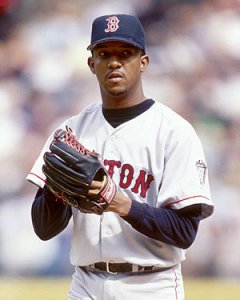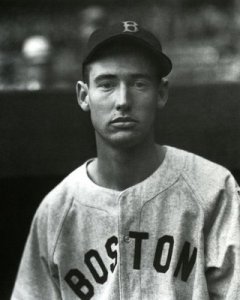(Note: This article was published by the author on another Red Sox web site prior to the establishment of this site.)
Who could have imagined the collective surprise of New York Yankee fans and the horror of Red Sox Nation when we picked up our Sunday papers and read that Alex Rodriguez, recently named captain of the Texas Rangers, would accept a trade to the Yankees in exchange for Alfonso Soriano (my personal Yankee favorite) and a player to be named later. Only two months before, it seemed certain that Rodriguez was coming to the Red Sox in exchange for Manny Ramirez to help bolster Boston’s chances of winning a World Series title for the first time in 86 seasons. Suddenly, the Sox brass are left to wonder if it was worth squabbling over a $4 million gap in exchange for his services. Even worse, Sox fans now wonder if this will rival the sale of Babe Ruth to the Yankees in 1920.
While the fallout of this trade is yet to be determined, I am again saddened to think that this is yet another example of why Major League Baseball is heading down a slippery slope from which it may never recover. The Yankees’ payroll now top the majors at $190 million and the Red Sox sit in second place, a mere $65 million short of that mark. Unfortunately, official numbers are not at my disposal, but after you get past the top five, I’m willing to guess that payrolls for the rest of the teams are less than half of the Yankees’ and, past the top ten, less than half of the Red Sox’s.
Believe me, I want to see the Red Sox win a World Series title at least once before I die. 2004 may be the best chance since… well, last season… for them to do this, and, since the disappointing end to the 2003 season, the Sox have brought in players like Curt Schilling and Keith Foulke to help bolster the pitching staff, the one chink in the armor from last season. The Yankees, of course, want to win another title even more, and this trade demonstrates that Yankees owner George Steinbrenner is less than satisfied with losing two of the last three World Series and will stop at nothing to stockpile his team with perennial All-Stars.
But, to paraphrase some of the Democratic candidates in this year’s election, there are the rich teams and then there are the other teams. While the Yankees, the Red Sox, and a handful of other teams continue to compete, the lesser teams fall by the wayside, having found themselves out of contention before the season begins. A team like Kansas City or Milwaukee may start the season on a hot streak, jumping ahead of the pack after a month or two, but by the time the All-Star game rolls around, these teams have been brought back down to earth and find themselves struggling to stay above .500 the rest of the way.
Just by ranking the payrolls of each team, it’s easy to see who are the haves and who are the have-nots. Teams with promising talent cannot retain them after initial contracts expire, so these players are snatched away by the big boys just to warm the bench, ready to step in when called. Other teams who find themselves with poor revenue and faced with offers of cash or other promising talent, unload what current stars they have at the trade deadline, hoping for some positive long term results that eventually fizzle.
It’s easy when you root for a big-market team like the Red Sox to underappreciate what you have. When a team can easily win 90 games or more per season, you overlook that fact and focus on the failures of the postseason. But, for what do the fans of these other teams cheer? Three-game winning streaks? All-Star selections not made to meet the quota of one-representative-per-team? Greg Vaughn bobblehead doll day? From the looks of half-empty stadiums all around baseball, it’s hard to see a reason to root, root, root for the home team.
From this, it’s easy to see why the National Football League, where parity is the flavor of the day, is swimming in the success of its popularity. True, on a cold Sunday afternoon in November, you’re more likely to be watching TV than holding a backyard barbecue or taking your boat out on the lake like you would on a summer afternoon. But, the balance in the NFL means that while your team may not make the playoffs one season, there is a good chance you will see them there next season. Thanks to a salary cap, it isn’t team spending that determines the top teams, it’s the ability to assess talent, like the New England Patriots have done, that helps to build champions.
If MLB wants to become America’s pasttime once more, I believe that it needs to do two things. To be fair, I’ve listed the most important change each side, players and owners, need to make.
1. Accept a payroll-equity solution
A luxury tax for teams over $150 million? Please! The only team that was forced to pay it after last season was… yes, the New York Yankees, and they don’t care because they have enough revenue to offset the cost. A salary cap that is within easy reach of all teams would force owners and management to start reassessing talent again and stop the big-market teams from tipping the scales. Not that a team could not afford more than a few superstars, but it’s hard to put together a quality team around these All-Stars with a weak supporting cast. The players union would, of course, be unhappy about this, but I scratch my head every time I see a second or third-tier player making $8 million or more per season; that makes no sense.
2. Hire a competent commissioner
Since Fay Vincent was forced out of office, the owners have ruined this game, no thanks in part to Bud Selig who, if not the most hated man in the baseball world, is in contention for that title. Whereas in the past, the commissioner has vetoed trades that were not felt to be in the best interest of baseball (Vida Blue, Red Sox fans?), Selig has allowed the owners to swap players with carefree glee, helping to escalate salaries and create the imbalance. Owners may be crying poverty, but when given control of the game, they were unable to agree on the best course and now they are in danger of running it aground. A stronger, independent-minded presence in this office is needed once again, as it was with Bowie Kuhn, Ford Frick, and Kenesaw Landis, to help steer baseball back on course.

